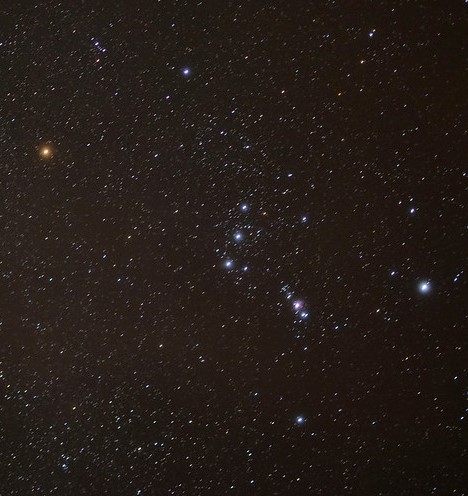
*Now with UPDATES, below:
Betelgeuse (pronounced Beetlejuice) is a star, the red one on the left shoulder of Orion. You’ve seen it. One of the whole points of stars is that you can just look up and count on seeing them. The earth turns underneath them so it’s true that depending on time and geography, when you look up you see different ones. But if you always look at the same time and from the same place, you’d always see the same ones, looking like they always look. Because that’s what stars are — they’re unchanging, fixed, steady**. People change, cities change, even the land changes. But this time of year, in Baltimore, I look out the south window and there’s Betelgeuse, always and evermore.
Well, it’s there but honest to God, something is wrong with it. That photo was taken in February 2019 — really, look at it and see how bright it is? Night before last, walking home from a neighbor’s, Betelgeuse was only as bright as Belletrix, the little blue star on Orion’s right shoulder. An Astronomers Telegram, ATel 13365, says it’s gone from being the 6th or 7th brightest star in the sky to the 21st. Since October, it’s been fainting, and that’s astronomers’ word for it, fainting, getting fainter. They’ve been measuring it for decades and it does normally become brighter and fainter: it’s a red giant, a star the size of our whole solar system, nearing the end of its life, and it normally puffs up and shrinks down. But right now, it’s dimmer than it’s ever been.
When Betelgeuse does die, it’ll go supernova and for a while, will be brighter than the moon. However, my astro-centric Twitter feed considers this unlikely, or rather — because nobody knows a lot about what happens just before a star goes supernova — too uncertain to get excited about. “Uncertain,” to an astronomer, means any time between now and 100 thousand years from now.
You might enjoy considering that since Betelgeuse is maybe 500 light years away, its light therefore taking maybe 500 years to reach us, it could have blown the better part of itself to smithereens in the 14th century and we wouldn’t know it yet.
From the universe’s point of view, red giants have been supernova-ing forever and Betelgeuse is just going about its normal business. But for us here, at night, going out to check the car, walking the dog, saying good night to the neighbors, turning on the porch light, looking up at what has always been a fixed, unchanging night sky, Orion seems profoundly wrong.
________
*UPDATED UPDATE: As of May, 2023, according to Betelgeuse’s own Twitter feed @betelbot, Betelgeuse is brightening once again. Astronomers are mostly worried that it will go behind the sun where they can’t see it and blow up in private.
*UPDATE: A few months after I wrote this, Betelgeuse started brightening again. But because astronomers never see a problem apparently fixing itself, shrug their shoulders, and call it a day, they went back into the data archives of the Hubble Space Telescope. And this mysterious dimming turns out to have been caused by Betelgeuse sending out a giant flare of hot gas that came straight at us, then cooled and formed dust, and the dust did the dimming. Betelgeuse could still be in the early stages of supernova-ing — we’ll just have to wait and see. “We” maybe meaning our great-grandchildren but still.
**This is true only from the ground, by eye, on the whole. Using telescopes and instruments that record light (i.e., see) a few photons at a time and in all of light’s wavelengths, the sky is anything but unchanging. It’s a full-on party out there.
Photo by Alejandra Lagos Brand, somewhat cropped, via Flickr.
The night sky isn’t quite as static as you think it is. Betelgeuse is a variable star, one of many that can be seen, and it has been varying in brightness since there have been humans to look up at it. Even Polaris, the famous North Star is a variable. Algol is a star that dims visibly every 2.87 days. Here’s a list of some other naked eye variables you might be interested in. https://www.skyandtelescope.com/observing/celestial-objects-to-watch/the-top-12-naked-eye-variable-stars/
Thanks for the updates, keep your eyes skyward.
Could someone explain to me why , 10 years ago this past October . What caused The Red Giant was Blocked out for days , when All other stars and star systems were visible?
I don’t know anything about this, Deborah. But red giants are kind of messy and might have dust and stuff around them that could block their light temporarily.
Cool story, would be great to witness it go super. Nothing big, but I thought it was pronounced ‘BAY-tul-juice’Cheers!
Ann, when you figure out how to pronounce Betelgeuse, let us know. Astronomers haven’t figured it out!
I observed – let me call it HR2061 – with a tiny telescope back at CTIO to get a spectrum of it. It is not easy observing a bright star with a telescope! I tried to get a spectrum of all the bright stars in the southern sky while we still had a spectrograph on a small telescope.
When I am feeling facetious and someone asks me why I like to observe exploding stars, I like to say that I enjoy supernovae because there is one less star in the sky to study. I have to say I would miss, let’s say, HD39801 though. The blue Rigel and the red, ummm, α Ori give Orion a beautiful symmetry.
I would indeed have been better advised to say that I, me, I myself pronounce it beetlejuice. But alpha Orionis, that’s prettier. Let’s go with that.
Also, Nick, you’re funny.
It’s all wonderful